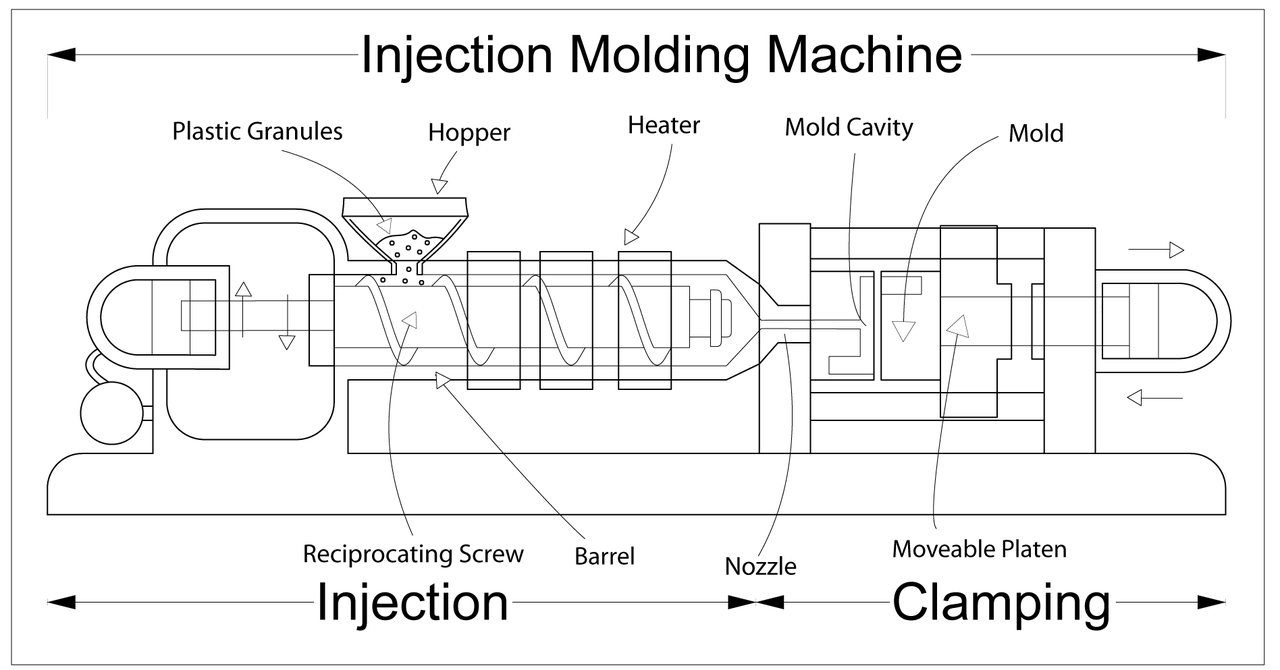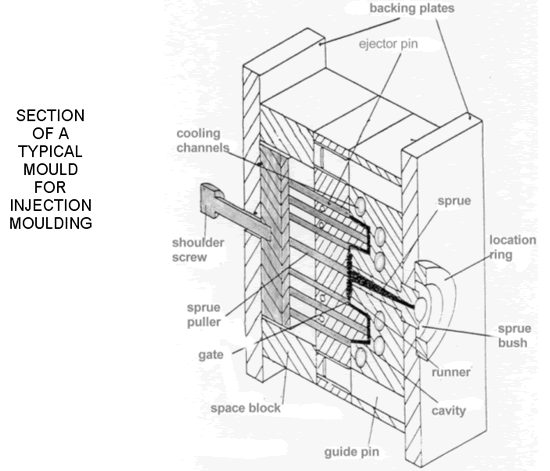Injection Molding Basics
By: Ron Dietz
High pressure injection molding is one of the basic manufacturing technologies in modern times. There are three broad categories of materials that are utilized in this process: plastics, rubbers/silicone, and metals. Generally, the material is in a hot liquid state so that it can be forced flowed under high pressure into a suitable die which has the shape of the part that is required. This article will focus on two common processes: plastic injection molding and die casting. The same principles can be applied to other materials as well.
Plastic Injection Molding:
Process:
In the plastic injection molding process, molten plastic is injected into a suitable mold under extremely high pressure that rapidly fills the mold cavities. The picture below shows the most common machine.
The machine is filled from the hopper with granules of the type of plastic that you want to mold with. As the granules get transferred down the barrel by the screw action, they are heated through a combination of the heated barrel and friction forces. This liquid molten plastic is then rammed through the nozzle by the rear hydraulic cylinder into the mold cavity. The front hydraulic cylinder is used to hold the mold in place and to resist the forces of the rear cylinders. This resisting forces can easily exceed 4/5 tons/in² of projected part area. Because of these large injection pressures and resisting forces the dies must be designed, analyzed, and manufactured to a high standard-which can easily run into the hundred of thousands of dollars for just one mold-(as an aside, the sections of this website that deal with injection molding technology will be focusing on the tooling almost exclusively).
Materials:
Thermosetting, thermoplastics, and elastomer materials can be used in the injection molding process. However, at this point in time the vast majority are the thermoplastic materials. It has be estimated that there are over 18,000 different materials currently in use-with more being developed all the time. These materials also include blends of plastics and alloys which can yield extremely useful material properties for certain applications. Further, new materials are being researched and develop all the time by different manufacturing companies. More information on some of the materials out there can be learned from sources such as http://www.dupont.com/products-and-services/plastics-polymers-resins.html
Tooling:
The tooling for plastic injection molding is some of the most complex tooling in the current state of the art of manufacturing. Plastic injection mold tooling is so complex and sophisticated that this website will be devoting many, many articles to discuss this important aspect of the molding process. Briefly, the basics will be covered.
The simplest mold used in plastic injection molding is called the two plate mold with a single part cavity that is to be filled with the molten plastic, or material. The top plate is referred to as the “A” plate and the bottom plate the “B” plate respectively. Here is a simplified cross section of a typical mold:
In the picture the dark outline of the molded part can be seen as well as some of the additional components that go with most molds. Plates must be designed to withstand the high pressures of the molding process. The must be the right thickness and be of the right material. Sprue bushing and location ring need to be installed precisely to aligned with plastic injection mold machine. Guide pins, ejector pins, sprue pullers, and cooling channels machined into the plates all have to be designed; they have to be correctly specified and installed correctly. Surface finishes, tool plate heat treatments, and tolerances are further critical items of interest in the designing and building of tooling-the list goes on. Whole books have been and can be written on this subject alone-and further research is always on-going. This website will come back to plastic injection mold tooling again and again.
Summary:
Plastic Injection molding is a complex but extremely useful manufacturing process. It can produce high quality parts in a high volume at low cost. Outside of the injection machine itself, the tooling is the most complicated part, each tool is custom made for the the part design. The tooling is also very high cost and requires competent design, high craftsmanship, and high quality to last for years in the manufacturing process.
References:
Ron Dietz is the Editor-in-Chief for Tooling Magazine.
He has a BS in Mechanical Engineering and an MS in Engineering.
He has 18 years experience in metal manufacturing as a welder, machinist, tooling engineer, and machine designer.
His main interests are CNC machine designs, automated machinery, and complex tooling.
FAIR USE NOTICE. This site contains copyrighted material the use of which has not always been specifically authorized by the copyright owner. We are making such material available in our efforts to advance understanding of economic, scientific, and engineering issues, etc.. We believe this constitutes a ‘fair use’ of any such copyrighted material as provided for in section 107 of the US Copyright Law. If you wish to use copyrighted material from this site for purposes of your own that go beyond ‘fair use’, you must obtain permission from the copyright owner.

